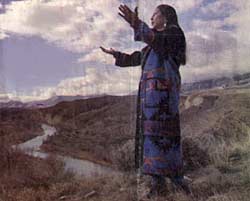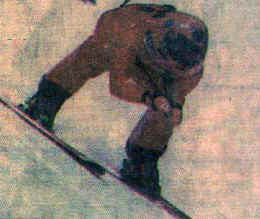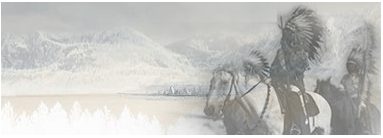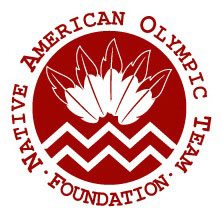Indian Country Today
Native
children learn to ski,
join Red Road to the Olympics
Cate Montana - Today Staff
FORT HALL, Idaho - The Utes and
the Navajo call her Snow Woman and rightly so.
Captain of the U.S. Woman's Olympic ski team at Grenoble in
1968 and three-time world champion freestyle skier, Suzy Chaffee's
element is snow and the mountains are her heart's kingdom.
America's ski darling for
decades, since 1967 Chaffee has focused on helping tribes and their
youth reconnect with the world of snow by opening the mountains and
high passes of their former territories back up to them through
skiing.
 Through
Native American Olympic Team Foundation, which she established in 1996 with
Colorado Ute Unity Leader, Alden Naranjo, Chaffee is building
partnerships between Indian nations, U.S. ski resorts and athletes
form around the world.
Through
Native American Olympic Team Foundation, which she established in 1996 with
Colorado Ute Unity Leader, Alden Naranjo, Chaffee is building
partnerships between Indian nations, U.S. ski resorts and athletes
form around the world.
In the past two years, Chaffee
helped more than 1,000 Indian children learn to ski by setting up a
cross-culturally exchanged between tribes and ski areas. Exclusive
resorts such as Aspen and Vail opened their doors to Native dances
and healing ceremonies. Pristine
mountain slopes ring with chants not heard for more than a century.
In exchange for healing and
cultural presentations, resorts give thousands of dollars in lift
tickets, ski lessons and equipment rentals to Indian children,
opening up the opportunity for them to learn to "fly like
eagles" down the slopes of their native homes.
It is the ecstasy of such an
experience Chaffee wants to pass on to Indian youth.
"Skiing opened up so many doors
to a magical life, that my way of giving back is to help ensure that
future generations will have these joyful opportunities in these
majestic opportunities in these majestic mountains," Chaffee says.
"In welcoming back Native Americans to their ancestral land, to
honor their gifts of ecology and democracy and share the joy of
skiing, ski areas are finding that the sustainable wisdom of our
First Americans is rubbing off."
Ski areas and tribes also find
mutual cooperation is paying off.
This ski season Chaffee's focus
is on the "Red Road to the Olympics."
From the Penobscot and Passamquoddy tribes in Maine to the
Ute, Paiute and Goshute tribes of Utah, Native American Olympic Team Foundation
unites tribes and their local ski resorts in an effort to coach the
"best of the best" skiers and snowboarders in Indian country.
Chaffee plans to coordinate the
finest young Indian skiers and snowboarders a the foundation helps
hit the slopes this season, incorporating then in ceremonies and
events schedules during the Winter Olympics in Salt Lake City next
year.
"She is nurturing our youth to
have Olympic dreams with her credibility and enthusiasms," says
Rose Ann Abrahamson, cultural coordinator for the Native American
2002 Foundation. "You
should see the students when they are around her.
She's giving these children the opportunity to experience
the Olympic experience . nurturing then with the hope that someday
they can be an Olympic champion."
The Salt Lake Organizing Committee
has invited wide-scale participation form American Indians during
the Olympics. Although
plans for the ceremonies a re extremely hush-hush, it is clear the
Native profile will be high. Chaffee
sees a tremendous opportunity for tribes to come to the cultural and
spiritual forefront at the international level during the Games and
is doing her best to facilitate the Native American Olympic Team Foundation.
"In welcoming back Native
Americans to their ancestral land, to honor their gifts of ecology
and democracy and share the joy of skiing, ski areas are finding
that the sustainable wisdom of our first Americans is rubbing
off," says skier Suzy Chaffee.
If the recent World Cup
competition at Park City, Utah, is any example, Chaffee's and
tribe's efforts will bear fruit.
At the World Cup in November,
Europeans, Asian, and American spectators watched as the mountain
was blessed and the four cardinal directions honored in Paiute, Ute
and Navajo by the president of the southern Paiute tribe.
Abrahamson, a world champion dancer and a descendent of the
Lemhi-Shoshone Sacajawea, headed up a group of Native American
ambassadors who welcomed and congratulated competitors at the finish
line. World champion
fancy dancer Darl Jack dazzled everyone with his spirit and
athleticism. Recording
artists Herman Begay sang traditional songs that echoed through the
Wasatch Mountains.
"This ceremony was an ideal way
to star this important warm up season," said Park City event
coordinator Ed Fraze. "the
Native prayers for the mountain and competitors.gave everyone a
lift. "The feedback
has been fantastic." So
far a handful of tribes have committed to participate in the Native American Olympic Team Foundation and the Red Road to the Olympic effort.
Chaffee and Abrahamson hope to have children form at least 20
tribes from all areas of the country represented at the Olympics
next year. But
contributions are needed to help make the magic happen for the
estimated 2,000 youngsters who could be part of the program this
season.
Although the resorts supply
lessons, equipment, lift tickets and even transportation to the
slopes, individuals and organizations are needed to help supply
accommodations for the young people who ski and tribal members who
participate in dances and ceremonies.
Simple but vital things like ski gloves, jackets and pants
for the young people are still needed.
 Chaffee
and Abrahamson hope tribes will take advantage of Olympic fever to
make permanent inroads at the resorts.
They also hope they will step forward to help-even if
it's just supplying a day's lunches for the kids.
Chaffee
and Abrahamson hope tribes will take advantage of Olympic fever to
make permanent inroads at the resorts.
They also hope they will step forward to help-even if
it's just supplying a day's lunches for the kids.
"I want to find the biggest
hearted tribes and the biggest hearted ski areas in each state of
region," says Chaffee, "And it will spread to the other ski
areas in each state like it did in Colorado."
Honoring Natures' Laws
Chaffee is the first person to
admit her efforts are based upon the foundation of time and other
people's contributions.
Recognition of tribes'
importance began to dawn in the 1970's at Vial, where tribal
medicine men "saved their butts," as Chaffee puts it, when lack
of snow threatened resort economics. Medicine men agreed to help and performed ceremonies blessing
the cardinal directions in invoking the snows.
The result? It snowed and snowed and snowed.
Although resort administrative
staff were both impressed and relieved, Chaffee said they really
didn't honor the tribes for their contribution.
"It was more of a Republican
economic thin," she says. "But it was a start."
Chaffee, who had been coached by
an Abenaki tribal member in Vermont when she was 5, also learned a
profound respect for tribes and their knowledge of the natural world
and its laws. Using:
chairlift diplomacy" she impressed the powers that be with the
advantage of further cooperation.
"I went to them ad said,
"Look. If you were are Creator and you were thinking about
blessing a place with some snow, would you look even more fondly on
a ski area that also honored the guardians of Mother Earth who did
the ceremony?
"And the said, "Yeah, I guess
that makes some sense."
Today, with the environment in
obvious trouble people involved in outdoor sports are waking up to
their responsibilities. Resort
administrators are welcoming sacred ceremonies for more reasons that
the economic bottom line. They
welcome the examples of care-taking and wisdom that the tribes
provide.
And tribal children reap the
harvest of cross-cultural unity.
"All of these tribes used to
have mountain vision quests," Abrahamson says. "Their spiritual
connection with the mountains, to be up there where the eagles fly,
to be there, close to the Creator, to be there within the strength
and the power of the mountains.I think that's been lost.
"She's bringing it back to
them through a very thrilling sport that many of our children can
ill afford."
Cate Montana reports form the Pacific Northwest
Indian Country Today, Wednesday, December 13, 2000

